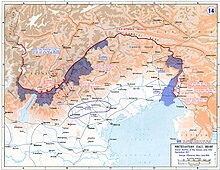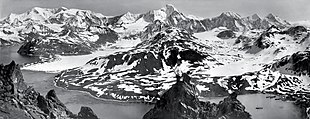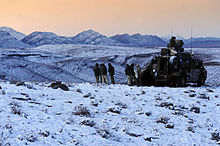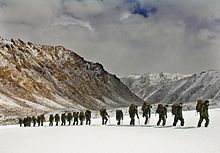Mountain warfare

| Part of a series on |
| War Outline |
|---|
 |
Mountain warfareoralpine warfareiswarfareinmountainsor similarly rough terrain. The term encompassesmilitary operationsaffected by the terrain, hazards, and factors of combat and movement through rough terrain, as well as the strategies and tactics used bymilitaryforces in these situations and environments.
Mountain ranges are of strategic importance since they often act as anatural borderand may also be the origin of awater sourcesuch as theGolan Heights.Attacking a prepared enemy position in mountain terrain generally requires a greater ratio of attacking soldiers to defending soldiers than a war conducted on level ground. Mountains present natural hazards such aslightning,strong gusts of wind,rockfalls,avalanches,snowpacks,ice,extremecold,andglacierswith theircrevasses;in these ways, it can be similar tocold-weather warfare.The generally uneven terrain and the slow pace of troop and material movements are additional threats to combatants. Movement, reinforcements, andmedical evacuationup and down steep slopes and areas in which evenpack animalscannot reach involves an enormous exertion of energy.[1]
History[edit]
Second Punic War[edit]
In 218 BC (DXXXVIAUC), the Carthaginian army commander Hannibal marched troops, cavalry and African elephants across the Alps in an effort to conquer Rome by approaching it from north of the Italian Peninsula. The Roman government was complacent because the Alps were viewed as a secure natural obstacle to would-be invaders. In December 218 BC, the Carthaginian forces defeated Roman troops, in the north, with the use of elephants. Many elephants did not survive the cold weather and disease typical of the European climate. Hannibal's army fought Roman troops in Italy for 15 years but failed to conquer Rome. Carthage was ultimatelydefeatedby Roman generalScipio Africanusat Zama inNorth Africain 202 BC (DLII AUC).[2]
Early history[edit]


The term mountain warfare is said to have come about in theMiddle Agesafter the European monarchies found it difficult to fight theSwissarmies in the Alps because the Swiss fought in smaller units and took vantage points against a huge unmaneuverable army. Similar styles of attack and defence were later employed byguerrillas,partisansand irregulars, who hid in the mountains after an attack, which made it challenging for an army of regulars to fight back. InNapoleon Bonaparte's Italian campaign,Suvorov'sItalian and Swiss expeditionand the1809 rebellioninTyrol,mountain warfare played a large role.[3]
Another example of mountain warfare was theCrossing of the Andes,which was carried out by the ArgentineanArmy of the Andes(Spanish:Ejército de los Andes), commanded by GeneralJosé de San Martínin 1817. One of the divisions climbed mountains surpassing 5000 m in height.[4]
TheCaucasian Warwas a 19th century military conflict between theRussian Empireand variouspeoples of the North Caucasuswho resisted subjugation during theRussian conquest of the Caucasus.
The firstBritish invasion of Afghanistanended in disaster in 1842, when 16,000 British soldiers and camp followers were massacred as theyretreatedthrough theHindu Kushback to India.[5]
World War I[edit]

Mountain warfare came to the fore once again duringWorld War I,when some of the nations that were involved in the war had mountain divisions that had not been tested. TheAustro-Hungariandefence repelledItalian attacksby taking advantage of the terrain in theJulian Alpsand theDolomites,wherefrostbiteand avalanches proved deadlier than bullets.[6]During the summer of 1918, theBattle of San Matteotook place on theItalian frontand was fought at the highest elevation of any during the war. In December 1914, anotheroffensive was launchedby theOttomansupreme commanderEnver Pashawith 95,000–190,000 troops against theRussiansin theCaucasus.Insisting on a frontal attack against Russian positions in the mountains in the heart of winter, the result was devastating, and Enver lost 86% of his forces.[7]
World War II[edit]
Examples of mountain warfare used duringWorld War IIinclude theBattles of Narvik,Battle of the Caucasus,Kokoda Track campaign,Battle of Attu,Operation Rentier,Operation Gauntlet,Operation Encore,and the British defence at theBattle of Hong Kong.
This sectionneeds expansionwith: details on these operations; this is presently just a list that does not delve into mountain warfare during World War II. You can help byadding to it.(March 2020) |
One ambush tactic used against the Germans during theBattles of Narvikutilisedhairpin bends.Defenders would position themselves above them and open fire when attackers reached a certain point below, parallel to themselves. This would force the attackers to: retreat; to continue under fire; or to attempt to climb the mountain another way. The tactic could be planned in advance, or employed by a retreating force.[8]
Another tactic utilised was the 'ascending platoon attack'. Attackers would scout higher enemy positions from the ground, aided by bad weather or poor visibility. ALight Machine Gun(LMG) team would open fire towards the high enemy position from a distance, offering cover for the remaining soldiers to gradually advance.[8]
Kashmir conflicts[edit]

Since thePartition of Indiain 1947,IndiaandPakistanhave been in conflict over theKashmir region.They have fought two wars and numerous additional skirmishes or border conflicts in the region.[9]Kashmir is located in theHimalayas,the highest mountain range in the world.[10]
The first hostilities between the two nations, during theIndo-Pakistani War of 1947,showed that both were ill-equipped to fight in biting cold, let alone at the highest altitudes in the world.[11]During theSino-Indian Warof 1962, hostilities broke out between India andChinain the same area.[9]
The subsequentIndo-Pakistani War of 1965between India and Pakistan was mainly fought in Kashmir's valleys, rather than the mountains themselves, but several mountain battles took place. During theKargil War(1999), Indian forces sought to flush out opponents who had captured high mountain posts. That proxy war was the only modern war that was fought exclusively in the mountains.[12]After the Kargil War, the Indian Army implemented specialist training on artillery use in the mountains, where ballistic projectiles have different characteristics than at sea level.[13]
Falklands War[edit]

Most of theFalklands Wartook place on hills in semi-Arctic conditions on theFalkland Islands.However, during the opening stage of the war, there was military action on the bleak mountainous island ofSouth Georgia,where a British expedition sought to eject occupying Argentine forces. South Georgia is aperiantarctic island,and the conflict took place during the southern winter and so Alpine conditions prevailed almost down to sea level. The operation (codenamedOperation Paraquet) was unusual in that it combined aspects of long-rangeamphibious warfare,arctic warfareand mountain warfare. It involved several ships,special forcestroops andhelicopters.[14]
War in Afghanistan[edit]


Throughout history but especially since 1979, many mountain warfare operations have taken place throughoutAfghanistan.Since thecoalition invasion of Afghanistanin 2001, they have been primarily in the eastern provinces ofKunarandNuristan.[15]
Kunar and eastern Nuristan are strategic terrain since the area constitutes a major infiltration route into Afghanistan, and insurgents can enter the provinces from any number of places along the border withPakistanto gain access to a vast network of river valleys. In that part of Afghanistan (Regional Command East), theUS militaryadopted a hybrid style of mountain warfare incorporatingcounterinsurgency(COIN) theory in which the population is paramount as the center of gravity in the fight.[16]
In counterinsurgency, seizing and holding territory are less important than avoiding civilian casualties. The primary goals of counterinsurgency are to secure the backing of the populace and thereby to legitimize the government, rather than to focus on militarily defeating the insurgents. Counterinsurgency doctrine has proved difficult to implement in Kunar and Nuristan. In the sparsely-populated mountain regions of eastern Afghanistan, strategists have argued for holding the high ground, a tenet of classical mountain warfare. The argument suggests that if the counterinsurgent does not deny the enemy the high ground, the insurgents can attack at will. In Kunar and Nuristan, US forces continued to pursue a hybrid style of counterinsurgency warfare, with its focus onwinning hearts and minds,and mountain warfare, with the US forces seizing and holding the high ground.
Training[edit]


The expense of training mountain troops precludes them from being on theorder of battleof most armies except those that reasonably expect to fight in such terrain. Mountain warfare training is arduous and in many countries the exclusive preserve of elite units such asspecial forcesorcommandos,which as part of their remit should have the ability to fight in difficult terrain such as theRoyal Marines.Regular units may also occasionally undertake training of this nature.
See also[edit]
References[edit]
- ^"Research report"(PDF).rand.org.Retrieved2020-01-26.
- ^Ball, Philip (April 3, 2016)."The truth about Hannibal's route across the Alps".The Observer– via theguardian.
- ^"PBS - Napoleon: Napoleon at War".pbs.org.
- ^"Data"(PDF).loc.gov.Retrieved2020-01-26.
- ^Stewart, Terry."Britain's Retreat from Kabul 1842".Historic UK.
- ^Chow, Brian Mockenhaupt, Stefen."The Most Treacherous Battle of World War I Took Place in the Italian Mountains".Smithsonian Magazine.
{{cite web}}:CS1 maint: multiple names: authors list (link) - ^"Siachen Glacier: Mountain Warfare".siachenglacier.
- ^abBull, Stephen (2013).World War II Winter and Mountain Warfare Tactics.Great Britain:Osprey Publishing.pp. 20–21.ISBN9781849087131.
- ^ab"The Kashmir conflict: How did it start?".Culture.March 2, 2019. Archived fromthe originalon March 5, 2019.
- ^"Himalayan Peaks".its.caltech.edu.
- ^"Indo-Pakistani Conflict of 1947-48".globalsecurity.org.
- ^Abbas, Zaffar (July 30, 2016)."When Pakistan and India went to war over Kashmir in 1999".Herald Magazine.
- ^"Archived copy"(PDF).Archived fromthe original(PDF)on 2018-04-13.Retrieved2020-01-07.
{{cite web}}:CS1 maint: archived copy as title (link) - ^"Sink the Belgrano",Mike Rossiter, 2007, Transworld, London, pp 189–233
- ^"On the ground in Afghanistan"(PDF).marines.mil.2012.Retrieved2021-03-20.
- ^Marks, Thomas A. (2005). "Counterinsurgency and Operational Art".Low Intensity Conflict & Law Enforcement.13(3): 168–211.doi:10.1080/09662840600560527.S2CID144725353.
Sources[edit]
- Frederick Engels,(January 27, 1857) "Mountain Warfare in the Past and Present"New York Daily TribuneMECW Volume 15, p 164
Further reading[edit]
- Govan, Thomas P. (1946-09-01).Training for mountain and winter warfare.AGF Study, no. 23. [Washington, D.C.]: Historical Section, Army Ground Forces. Archived fromthe originalon May 27, 2012.Retrieved2011-01-28.
- Malik, Muhammad Asim (2004-09-10)."Mountain warfare: the need for specialized training"(PDF).Military Review.84(5): 94–102.ISSN0026-4148.OCLC2558412.Retrieved2011-01-28.[permanent dead link]
- Pierce, Scott W. (2008-05-22).Mountain and cold weather warfighting: critical capability for the 21st century.SAMS Monograph. Fort Leavenworth, Kans.: School of Advanced Military Studies, United States Army Command and General Staff College. Archived fromthe originalon May 27, 2012.Retrieved2011-01-28.
External links[edit]
- Official page of documentary film GLOBAL WARNING on the Mountain War 1915–1918Global Warning
- Mountain War in World War IThe war in the Italian Dolomites (Italian)
- Historic films showing Mountain Warfare in World War I ateuropeanfilmgateway.eu
- Mountain Combat World War IIMilitaria: Combat Lessons
- High Altitude Warfare School of the Indian Army[1]
- Official Italian Army website page on Alpine Troops Command[2]
- Official page of 11th Mountain Infantry Battalion (Brazil)[3]
